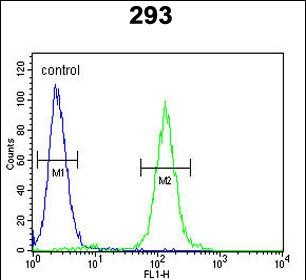SUV4-20H2 Antibody (Center)
Purified Rabbit Polyclonal Antibody (Pab)
- SPECIFICATION
- CITATIONS: 1
- PROTOCOLS
- BACKGROUND

Application
| WB, FC, E |
|---|---|
| Primary Accession | Q86Y97 |
| Other Accession | P0C2N6, Q6Q783 |
| Reactivity | Human, Mouse |
| Predicted | Rat |
| Host | Rabbit |
| Clonality | Polyclonal |
| Isotype | Rabbit IgG |
| Calculated MW | 52113 Da |
| Antigen Region | 195-220 aa |
| Gene ID | 84787 |
|---|---|
| Other Names | Histone-lysine N-methyltransferase SUV420H2, Lysine N-methyltransferase 5C, Suppressor of variegation 4-20 homolog 2, Su(var)4-20 homolog 2, Suv4-20h2, SUV420H2, KMT5C |
| Target/Specificity | This SUV4-20H2 antibody is generated from rabbits immunized with a KLH conjugated synthetic peptide between 195-220 amino acids of human SUV4-20H2. |
| Dilution | WB~~1:1000 FC~~1:10~50 E~~Use at an assay dependent concentration. |
| Format | Purified polyclonal antibody supplied in PBS with 0.09% (W/V) sodium azide. This antibody is prepared by Saturated Ammonium Sulfate (SAS) precipitation followed by dialysis against PBS. |
| Storage | Maintain refrigerated at 2-8°C for up to 2 weeks. For long term storage store at -20°C in small aliquots to prevent freeze-thaw cycles. |
| Precautions | SUV4-20H2 Antibody (Center) is for research use only and not for use in diagnostic or therapeutic procedures. |
| Name | KMT5C (HGNC:28405) |
|---|---|
| Synonyms | SUV420H2 |
| Function | Histone methyltransferase that specifically methylates monomethylated 'Lys-20' (H4K20me1) and dimethylated 'Lys-20' (H4K20me2) of histone H4 to produce respectively dimethylated 'Lys-20' (H4K20me2) and trimethylated 'Lys-20' (H4K20me3) and thus regulates transcription and maintenance of genome integrity (PubMed:24396869, PubMed:28114273). In vitro also methylates unmodified 'Lys-20' (H4K20me0) of histone H4 and nucleosomes (PubMed:24396869). H4 'Lys-20' trimethylation represents a specific tag for epigenetic transcriptional repression. Mainly functions in pericentric heterochromatin regions, thereby playing a central role in the establishment of constitutive heterochromatin in these regions. KMT5C is targeted to histone H3 via its interaction with RB1 family proteins (RB1, RBL1 and RBL2) (By similarity). Facilitates TP53BP1 foci formation upon DNA damage and proficient non-homologous end-joining (NHEJ)-directed DNA repair by catalyzing the di- and trimethylation of 'Lys-20' of histone H4 (PubMed:28114273). May play a role in class switch reconbination by catalyzing the di- and trimethylation of 'Lys-20' of histone H4 (By similarity). |
| Cellular Location | Nucleus. Chromosome. Note=Associated with pericentric heterochromatin. CBX1 and CBX5 are required for the localization to pericentric heterochromatin (By similarity). |

Provided below are standard protocols that you may find useful for product applications.
Background
SUV420H2 is a histone methyltransferase that specifically trimethylates 'Lys-20' of histone H4. H4 'Lys-20' trimethylation represents a specific tag for epigenetic transcriptional repression. The protein mainly functions in pericentric heterochromatin regions, thereby playing a central role in the establishment of constitutive heterochromatin in these regions. SUV420H1 is targeted to histone H3 via its interaction with RB1 family proteins (RB1, RBL1 and RBL2).
References
Souza,P.P., BMC Cell Biol. 10, 41 (2009)
Tryndyak,V.P., Cancer Biol. Ther. 5 (1), 65-70 (2006)
If you have used an Abcepta product and would like to share how it has performed, please click on the "Submit Review" button and provide the requested information. Our staff will examine and post your review and contact you if needed.
If you have any additional inquiries please email technical services at tech@abcepta.com.














 Foundational characteristics of cancer include proliferation, angiogenesis, migration, evasion of apoptosis, and cellular immortality. Find key markers for these cellular processes and antibodies to detect them.
Foundational characteristics of cancer include proliferation, angiogenesis, migration, evasion of apoptosis, and cellular immortality. Find key markers for these cellular processes and antibodies to detect them. The SUMOplot™ Analysis Program predicts and scores sumoylation sites in your protein. SUMOylation is a post-translational modification involved in various cellular processes, such as nuclear-cytosolic transport, transcriptional regulation, apoptosis, protein stability, response to stress, and progression through the cell cycle.
The SUMOplot™ Analysis Program predicts and scores sumoylation sites in your protein. SUMOylation is a post-translational modification involved in various cellular processes, such as nuclear-cytosolic transport, transcriptional regulation, apoptosis, protein stability, response to stress, and progression through the cell cycle. The Autophagy Receptor Motif Plotter predicts and scores autophagy receptor binding sites in your protein. Identifying proteins connected to this pathway is critical to understanding the role of autophagy in physiological as well as pathological processes such as development, differentiation, neurodegenerative diseases, stress, infection, and cancer.
The Autophagy Receptor Motif Plotter predicts and scores autophagy receptor binding sites in your protein. Identifying proteins connected to this pathway is critical to understanding the role of autophagy in physiological as well as pathological processes such as development, differentiation, neurodegenerative diseases, stress, infection, and cancer.


